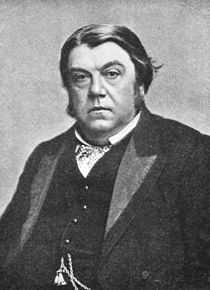Lawson Tait
| Lawson Tait | |
|---|---|
|
Lawson Tait | |
| Born |
May 1, 1845 Edinburgh, Scotland |
| Died |
June 13, 1899 Llandudno, Wales |
| Residence | Birmingham, England |
| Nationality | Scotland |
| Fields | Surgery, Gynaecology, Obstetrics |
| Institutions |
Birmingham Women's Hospital University of Birmingham Medical School |
| Known for | salpingectomy, appendectomy, ovariotomy, cholecystotomy, asepsis, Medical Defence Union |
| Influences | James Young Simpson |
Lawson Tait, born Robert Lawson Tait (May 1, 1845 – June 13, 1899) in Edinburgh, Scotland, became a pioneer in pelvic and abdominal surgery and developed new techniques and procedures. He emphasized asepsis and reduced surgical mortality significantly. He is well known for introducing salpingectomy in 1883 as the treatment for ectopic pregnancy, a procedure that has saved countless lives since then. Tait and J. Marion Sims are considered the fathers of gynecology.
Reducing surgical mortality
Tait's first success came with his demonstration that ovariotomy could be done safely. While Ephraim McDowell had successfully performed the first ovariotomy in Kentucky in 1809, mortality for this operation was over 90%. In his first paper in 1872, Tait reported only 1 death out of nine cases, a major breakthrough. His techniques of use of intraabdominal ligatures for the ovarian pedicle in favor of an extraperitoneal clamp, abdominal closure, and meticulous surgical cleanliness were novel and important for abdominal surgery. With further recognition, he was instrumental in the opening of the Birmingham Hospital for Women where he worked for 20 years.
Surgical milestones

During this time, his work included:
- First removal of an organ (ovary) for pain.
- Observation of association of cystic ovaries and excessive menstrual bleeding.
- Induction of surgical menopause by removal of ovaries.
- Removal of infected tubes.
- Drainage of pelvic abscess.
- First appendectomy 1880.
- First cholecystotomy (gallbladder surgery).
- Asepsis in lieu of Lister's antisepsis; he avoided the use of carbolic acid.
- Flushing of peritoneal cavity at end of operation.
Ectopic pregnancy
In 1881, it was suggested to him to remove the ruptured tube in case of an ectopic pregnancy. "... the suggestion staggered me, and I am ashamed to say that I did not receive it favorably." The postmortem examination convinced him that it could be done. So, 2 years later, Tait ligated the broad ligament and tube in another patient, and this patient survived. In 1888, Tait reported only 2 deaths out of 42 operated cases, a marked improvement for a condition that had been almost always fatal.
Anti-vivisectionist
Tait was a strong opponent to animal experimentation. His comment: " ...after we have found out what (experimental drugs) do in one animal we find that in another the results are wholly different and the process of investigation has to be repeated in man."
Tait was well recognized during his time, a founder and member of professional societies, and published extensively. He died of kidney failure.
Legacy
The Lawson Tait Society, an undergraduate history of medicine society at the University of Birmingham Medical School, is named in honour of Tait. They have embarked upon a project of digitising Tait's work and resources related to Tait.
Bibliography
- Tait L. Diseases of Women. New York: William Wood & Company; 1879.
References
- Risdon W. Robert Lawson Tait. London: National Anti-Vivisection Society; 1967. Digitised by the Lawson Tait Society
- Golditch, IM (2002). "Lawson Tait: The forgotten gynecologist". Obstetrics and gynecology 99 (1): 152–6. doi:10.1016/s0029-7844(01)01647-7. PMID 11777526.
- Greenwood, A (1998). "Lawson Tait and opposition to germ theory: defining science in surgical practice". Journal of the history of medicine and allied sciences (Apr 1998) 53 (2): 99–131. doi:10.1093/jhmas/53.2.99. PMID 9585686.
- Shepherd, J A (1986). "The contribution of Robert Lawson Tait to the development of abdominal surgery". Surgery annual 18: 339–49. PMID 3510469.
- "Classic pages in obstetrics and gynecology. Robert Lawson Tait. General summary of conclusions from one thousand cases of abdominal section". Am. J. Obstet. Gynecol. 118 (5): 717. 1974. PMID 4591897.
|
